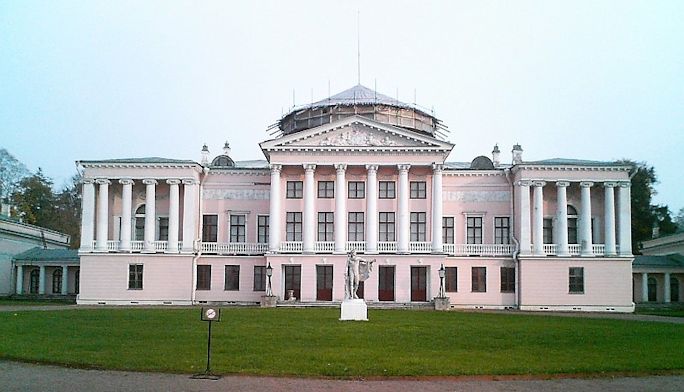Stars in the Darkness
by Polina Ivanova, Ritsumeikan University
The starting point for this post was a guide’s remark at the London Docklands Museum that some former slaves could achieve impressive social status. He gave an example of George Bridgetower, an Afro-European violin virtuoso whose father supposedly had escaped from slavery in Barbados. Bridgetower’s musical talent was noticed by Prince Regent (later George IV) who was overseeing his further musical education. Later, Bridgetower was composing and teaching in Europe, got acquainted with Beethoven and became a member of Royal Philarmonic Society.

Image: The Palace of Ostankin via [Wikimedia Commons]
I was reminded of a similar case in Russia: that of Ibrahim (Abraham) Hannibal, presumably an enslaved Eritrean sold in Turkey and offered as a gift to the Russian emperor Peter the Great who made Hannibal his godson. Hannibal studied in France and became a general, an engineer, a nobleman, and a great-grandfather of the country’s greatest poet Alexander Pushkin, often called “father of the Russian literature”.
Astonishing as they are, such “success stories” are extremely rare, dependent on luck and the patronage of high-ranking persons. They are still tainted with covert, if not open, discrimination and rejection by the mainstream society forcing newcomers to assimilate, convert, change their name and renounce their cultural identity. Hannibal reportedly cried at his baptism because he hated his new name. Ira Aldridge, the first Afro-American actor to perform in Britain professionally was not accepted by London audiences at first and leading newspapers of that time wrote racist reviews of his performances.
In 18th century Britain, most liberated slaves “lived alongside London’s poorer classes”. In Russia, despite somewhat better treatment of the black people, who were seen as exotic and desirable members of society, there was massive exploitation and slavery-like condition of local peasants called “serfdom” wide-spread also in current Ukraine and Belorussia in the 17-18th centuries (until its final abolition in 1861). Serf-like conditions varied from restriction of their freedom of movement to those similar to chattel slavery when serfs could be bought, sold or exchanged like in the poignant painting by Izhakevitch “Serfs Being Exchanged For Dogs”.
I believe that the legacy of serfdom is largely underestimated and misrepresented in the museums and public spaces today. After its abolition in 1861 and until the Russian revolution in 1917, the predominant narrative of serfdom was conservative and overly candid, portraying submissive peasants living in peaceful harmony with their kind owners. Such narrative closely echoes similar portrayal of the slave past in America (“Gone with the Wind” by M. Mitchell, “Uncle Tom’s Cabin” by H.B. Stowe).
Later, the communist government focused on peasant riots and famous rebels such as Stepan Razin, Emelyan Pugachev, and some abolitionists if they were suppressed by the Tsarist government (Decemberists), while the figures of the abolitionists closely affiliated with the government were unpopular. The reason for changing the dominant narrative was the desire of the new communist rulers to be seen as emancipators of serfs.
Consequently, there was more effort to show the serfs’ agency in the Soviet era compared to Russia today. This can be seen in the example of the palace Ostankino which opened as a museum for the public in 1918, soon after the Bolshevik revolution. In 1938, it was renamed “Museum of the Serf Artists” since the entire palace, its intricate decoration and theater were built by highly skillful serfs, and they also performed all the roles in the theater. Such name of the museum served to emphasize their agency and central role.
However, in 1992, following the collapse of the Soviet Union, the museum was renamed back to “The Palace of Ostankino”. Currently, the museum is undergoing renovation and is due to re-open in 2020. We can assume that the focus is likely to be on the palace owner, his innovative ideas in planning the palace and his luxurious lifestyle: the current website doesn’t mention any names of serf actors, and serf architects Argunov, Mironov and Dikushin are merely called “Russian architects”, not serfs. This contrast in museum representations under different political regimes seems quite revealing in how power structures frame history to serve their current political agendas.
Overall, all three narratives represent serfdom as “a thing of past”. However, I argue that the legacy of serfdom continues to affect the Russian population today. Opening a museum of serfdom with contemporary curating practices could be one of the ways to open a dialogue about the traumatic past and make the Russian public aware of its impact on today’s consciousness and current issues. Success stories of the oppressed, like stars on a dark background, should not blind us to tragic plight of millions of victims of slavery and slavery-like conditions, including serfdom.